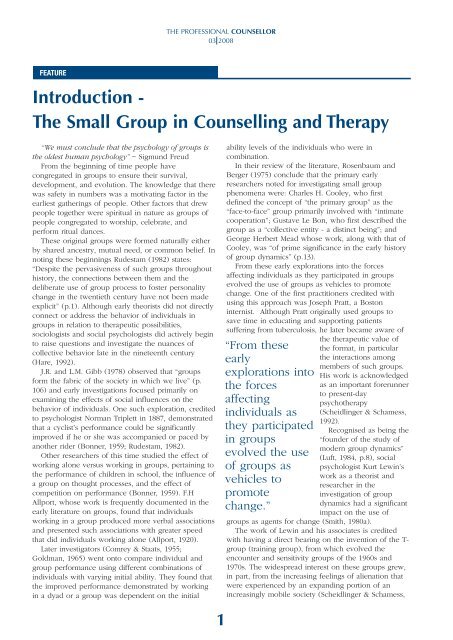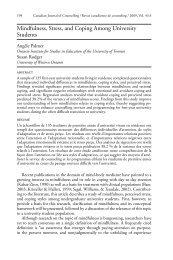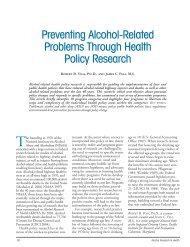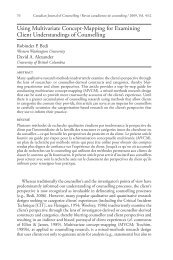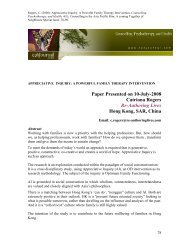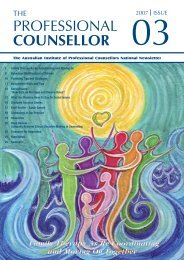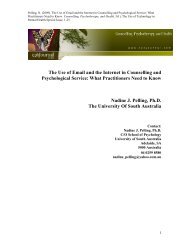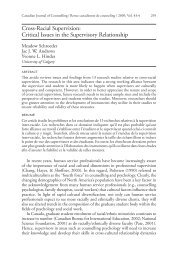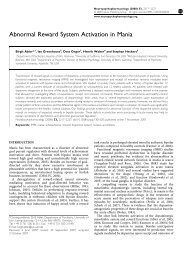PROFESSIONAL COUNSELLOR - Mental Health Academy
PROFESSIONAL COUNSELLOR - Mental Health Academy
PROFESSIONAL COUNSELLOR - Mental Health Academy
You also want an ePaper? Increase the reach of your titles
YUMPU automatically turns print PDFs into web optimized ePapers that Google loves.
THE <strong>PROFESSIONAL</strong> <strong>COUNSELLOR</strong><br />
03 2008<br />
FEATURE<br />
Introduction -<br />
The Small Group in Counselling and Therapy<br />
“We must conclude that the psychology of groups is<br />
the oldest human psychology” ~ Sigmund Freud<br />
From the beginning of time people have<br />
congregated in groups to ensure their survival,<br />
development, and evolution. The knowledge that there<br />
was safety in numbers was a motivating factor in the<br />
earliest gatherings of people. Other factors that drew<br />
people together were spiritual in nature as groups of<br />
people congregated to worship, celebrate, and<br />
perform ritual dances.<br />
These original groups were formed naturally either<br />
by shared ancestry, mutual need, or common belief. In<br />
noting these beginnings Rudestam (1982) states:<br />
“Despite the pervasiveness of such groups throughout<br />
history, the connections between them and the<br />
deliberate use of group process to foster personality<br />
change in the twentieth century have not been made<br />
explicit” (p.1). Although early theorists did not directly<br />
connect or address the behavior of individuals in<br />
groups in relation to therapeutic possibilities,<br />
sociologists and social psychologists did actively begin<br />
to raise questions and investigate the nuances of<br />
collective behavior late in the nineteenth century<br />
(Hare, 1992).<br />
J.R. and L.M. Gibb (1978) observed that “groups<br />
form the fabric of the society in which we live” (p.<br />
106) and early investigations focused primarily on<br />
examining the effects of social influences on the<br />
behavior of individuals. One such exploration, credited<br />
to psychologist Norman Triplett in 1887, demonstrated<br />
that a cyclist’s performance could be significantly<br />
improved if he or she was accompanied or paced by<br />
another rider (Bonner, 1959; Rudestam, 1982).<br />
Other researchers of this time studied the effect of<br />
working alone versus working in groups, pertaining to<br />
the performance of children in school, the influence of<br />
a group on thought processes, and the effect of<br />
competition on performance (Bonner, 1959). F.H<br />
Allport, whose work is frequently documented in the<br />
early literature on groups, found that individuals<br />
working in a group produced more verbal associations<br />
and presented such associations with greater speed<br />
that did individuals working alone (Allport, 1920).<br />
Later investigators (Comrey & Staats, 1955;<br />
Goldman, 1965) went onto compare individual and<br />
group performance using different combinations of<br />
individuals with varying initial ability. They found that<br />
the improved performance demonstrated by working<br />
in a dyad or a group was dependent on the initial<br />
ability levels of the individuals who were in<br />
combination.<br />
In their review of the literature, Rosenbaum and<br />
Berger (1975) conclude that the primary early<br />
researchers noted for investigating small group<br />
phenomena were: Charles H. Cooley, who first<br />
defined the concept of “the primary group” as the<br />
“face-to-face” group primarily involved with “intimate<br />
cooperation”; Gustave Le Bon, who first described the<br />
group as a “collective entity - a distinct being”; and<br />
George Herbert Mead whose work, along with that of<br />
Cooley, was “of prime significance in the early history<br />
of group dynamics” (p.13).<br />
From these early explorations into the forces<br />
affecting individuals as they participated in groups<br />
evolved the use of groups as vehicles to promote<br />
change. One of the first practitioners credited with<br />
using this approach was Joseph Pratt, a Boston<br />
internist. Although Pratt originally used groups to<br />
save time in educating and supporting patients<br />
suffering from tuberculosis, he later became aware of<br />
“From these<br />
early<br />
explorations into<br />
the forces<br />
affecting<br />
individuals as<br />
they participated<br />
in groups<br />
evolved the use<br />
of groups as<br />
vehicles to<br />
promote<br />
change.”<br />
the therapeutic value of<br />
the format, in particular<br />
the interactions among<br />
members of such groups.<br />
His work is acknowledged<br />
as an important forerunner<br />
to present-day<br />
psychotherapy<br />
(Scheidlinger & Schamess,<br />
1992).<br />
Recognised as being the<br />
“founder of the study of<br />
modern group dynamics”<br />
(Luft, 1984, p.8), social<br />
psychologist Kurt Lewin’s<br />
work as a theorist and<br />
researcher in the<br />
investigation of group<br />
dynamics had a significant<br />
impact on the use of<br />
groups as agents for change (Smith, 1980a).<br />
The work of Lewin and his associates is credited<br />
with having a direct bearing on the invention of the T-<br />
group (training group), from which evolved the<br />
encounter and sensitivity groups of the 1960s and<br />
1970s. The widespread interest on these groups grew,<br />
in part, from the increasing feelings of alienation that<br />
were experienced by an expanding portion of an<br />
increasingly mobile society (Scheidlinger & Schamess,<br />
1


